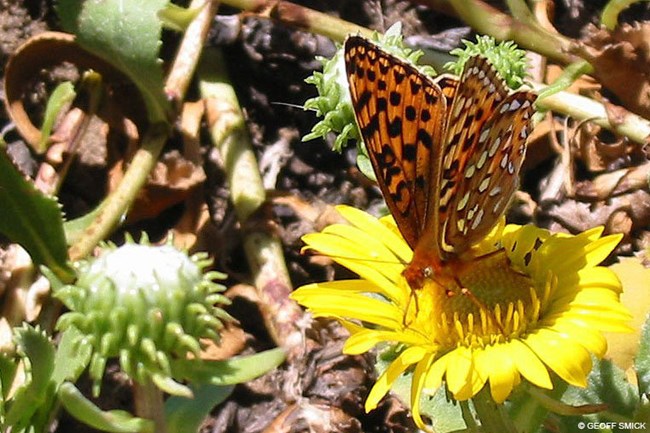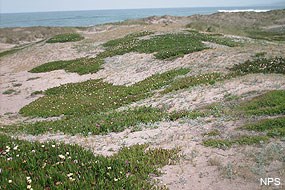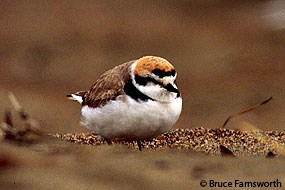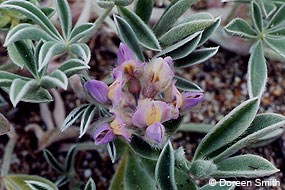|
coastal dune habitat restoration projects include: Why is Dune Restoration Important? 
© Geoff Smick Dunes are dynamic interfaces between the land and the sea. From afar, they appear somewhat barren landscapes of seemingly endless undulating mounds of sand, but, in reality, they teem with life. The ecologically precarious species, western snowy plovers (Charadrius nivosus nivosus), listed as federally threatened, nest at the oceanward edge of dunes, moving further inland at times for foraging. Federally endangered plants such as Tidestrom's lupine (Lupinus tidestromii) and beach layia (Layia carnosa) flourish in some of the interdunal basins within this otherwise seemingly arid landscape. Rare butterflies such as Myrtle's silverspot (Speyeria zerene myrtleae) forage on delicate violets and other vegetation within their midst. All in all, this unique habitat supports 11 federally listed plant and animal species. 
Unfortunately, as with many other unique habitats in California and the coast of the U.S., dunes have been tremendously impacted. Homes and businesses have been built to the edge of the sea. Where dunes remain, they have often been artificially stabilized by vegetation and fencing to prevent migration and impact to adjacent homes, businesses, farms, and ranches. Many of the plants brought in to stabilize dunes come from elsewhere and, once introduced, these non-native species spread rapidly, slowly encroaching into and eventually ousting the native plant species adapted to this environment—many of which have subsequently become threatened and endangered and are even on the brink of extinction. Some of the most common species planted to stabilize dunes are European beach grass (Ammophila arenaria), and iceplant (Carpobrotus spp). Not only do these non-native species displace rare and common native plant species, but, because most of these species form dense colonies, they actually retard the natural process of dune movement or migration. In natural communities, dunes continually move in response to wind pressure and wave action, typically forming morphologically and floristically distinct smaller foredune and slightly larger backdune communities. These dune systems are often characterized by relatively flat corridors between dunes that allow for movement of many animal species, including snowy plovers, and "slacks" or depressional basins where groundwater and precipitation form an aquatic oasis. Non-native species and their deep root and rhizome systems act to armor dune systems and prevent natural migration, which leads to overly large foredunes and backdunes, an impoverished native vegetation community, and a substantial decrease in value of this system to wildlife. 
This artificial armoring of dunes by non-native plants may have severe consequences in the future. Coastal environments are considered among the most vulnerable to changes from climate change, including direct changes (e.g. changes of temperature and precipitation) and indirect changes (e.g. sea level rise, wind and water circulation, increasing storm events). With rising sea levels, there will be more frequent and more serious flooding of low-lying coastal areas by extreme tides, storm surges, and wave effects. Coastal dunes offer a buffer against storm extreme tides and storm surges. This buffering capacity, however, is minimized and potentially eliminated when dunes are over-stabilized by invasive plant species or other alterations. Over-stabilization makes dunes more susceptible to loss from erosion by not enabling them to move or migrate naturally in response to sea level rise and changes in erosional patterns. Why is Dune Restoration Important in the Seashore? 
Some of the largest remnant dune systems in California can be found in Point Reyes National Seashore. There are approximately 16 miles of dunes along the Point Reyes Peninsula, Drakes, and Limantour coastlines. However, the Seashore's dunes are threatened by continued encroachment of European beachgrass and iceplant, which were planted decades ago to stabilize these systems. By 2009, more than 60% (1,400 acres) of the park’s roughly 2,200 acres of coastal dune, bluff, and scrub habitat had been invaded by European beachgrass and iceplant, and the areal extent of infested areas unfortunately continues to increase. 

Removal of beachgrass and iceplant from the Seashore's system of coastal dunes is important for many of the reasons that were discussed above—increase habitat for rare plants and animals, restore natural dune processes, provide more resilience to a vulnerable coastal ecosystem. However, the need for dune restoration has become more imperative even within just the past few years. Recent scientific and monitoring reports show that at least two of the primary species that use dune habitat within the Seashore are at immediate risk of extinction and that beachgrass may be one of the primary reasons. 
The western snowy plover nest on beach shores directly adjacent to foredunes, but, as the foredunes are currently dominated by European beachgrass, they not only do not provide foraging and refugia habitat for plovers, but instead act as habitat or cover for plover predators. Only 14 snowy plovers nested at the Seashore in 2010, down 66% (from 41%) in 1986, and only seven plovers nested in 2012 (NPS, unpub.data). Numbers did rebound somewhat in 2013 and 2014, climbing to 21 and 44 (as of August 2014), respectively, but the number of chicks successfully fledged still remains low. Although this precipitous decline may be due to factors affecting plovers outside the park, the lack of safe nesting habitat may also play a significant role. Nesting declines have happened despite extensive efforts by the park to educate beach visitors and to fence nests. A recent study correlated increases in European beachgrass cover with decreases in plover nesting attempts, concluding that plovers prefer open habitats for courtship and nesting because they can see their predators more easily (Muir and Colwell 2010). 
For years, biologists have known that European beachgrass and iceplant usurp dune areas that could otherwise support a myriad of rare plant species, including two federally endangered ones. However, recent research has shown that beachgrass not only impacts species such as Tidestrom's lupine directly, but indirectly. Beachgrass provides cover or habitat for native deer mice, which can eat up to 82% of the seed of Tidestrom's lupine (Dangremond et al. 2010). In fact, recently completed population viability analyses have shown that almost all of the Seashore's Tidestrom's lupine populations are on the brink of extinction, because they are not successfully reproducing due to seed predation (Dangremond et al. 2010; E. Pardini, Washington University, pers. comm.). The one exception, located south of AT&T dunes south of Abbotts Lagoon, is barely stable and did not reproduce successfully in 2010 for unknown reasons. If steps are not taken to remove European beachgrass and improve the success of reproduction, the Seashore could lose many of these populations in the near future. For these and many other reasons, the Seashore has embarked on an active program of restoration for its dune systems. Starting in 2001, it conducted a number of small-scale removal projects near Abbotts Lagoon that focused on manual and mechanical removal. Initial results were encouraging, particularly as some federally threatened and endangered species such as Tidestrom's lupine, appeared to increase (Peterson 2005). 
© 2002-2008 Kenneth & Gabrielle Adelman 
© 2002-2008 Kenneth & Gabrielle Adelman Based on these promising results, the Seashore started planning—and eventually implementing—a more ambitious project for removal just south of Abbotts Lagoon to remove up to 120 acres of European beachgrass from a 255-acre Project Area. A small pilot project was conducted in December 2009 to help refine construction approaches and cost estimates for the larger project that was being developed. In future years, the Seashore hopes to expand its restoration program southward along the Great Beach and on the dunes that border Drakes and Limantour Esteros. coastal dune habitat restoration projects include: Why is Dune Restoration Important? |
Last updated: May 27, 2024
